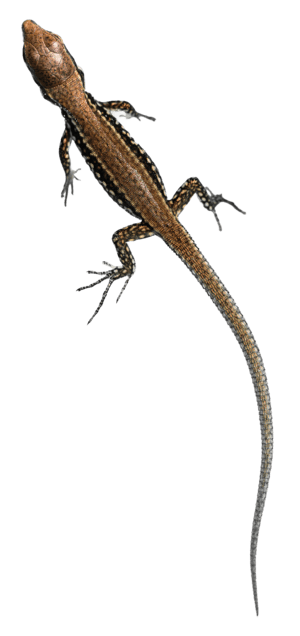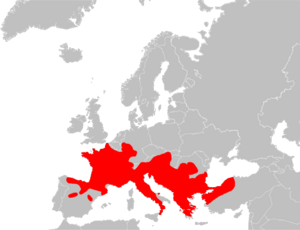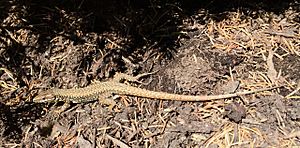Common wall lizard facts for kids
Quick facts for kids Common wall lizard |
|
|---|---|
 |
|
| Conservation status | |
| Scientific classification | |
 |
|
| Native range of P. muralis in Europe | |
| Synonyms | |
|
The common wall lizard, scientifically known as Podarcis muralis, is a fascinating reptile. It's a type of lizard that lives in many parts of Europe. You can also find it in North America, where it was introduced by people. In North America, it is sometimes called the European wall lizard. These lizards can grow to be about 20 centimeters (8 inches) long, including their tail.
Contents
What Does It Look Like?
The common wall lizard is a small and slender lizard. Its scales are tiny and come in many different colors and patterns. Usually, they are brownish or grayish. Sometimes, they might even have a hint of green.
Some lizards have a line of spots down their backs. Others might have a net-like pattern with dark spots on their sides. They can also have scattered white spots. These white spots might even be blue near their shoulders!
The tail is usually brown, gray, or a rusty color. It might also have light bars on its sides. The belly area has six rows of larger, rectangular scales. These scales are often reddish, pink, or orange. Some common wall lizards also have dark marks on their throats.
Scientists have identified six main looks for these lizards. These looks are based on the color of their throat and belly. Three of these are solid colors: white, red (or orange), or yellow. The other three are combinations of these colors, like white-yellow or yellow-red.
Where Do They Live?
Common wall lizards love rocky places. This includes cities, where they can hide among rocks, rubble, and buildings. They are very quick and can scurry away easily.
In warmer, southern areas, they often live in humid or somewhat wet places. But in cooler, northern areas, they prefer drier spots.
How Do They Communicate?
These lizards use scent to talk to each other. Female wall lizards can tell the difference between males just by their smell. They can even tell which males are stronger or more dominant.
Males that are stronger tend to produce more of a special scent. Females will flick their tongues more often when they smell these stronger males. This shows they are interested in them.
Where Are They Found and Are They Safe?
The common wall lizard naturally lives across most of mainland Europe. You won't find them in the far north or very far south of Europe. Their natural home also extends into Turkey.
They have also been introduced to other places. You can find them in southern Great Britain. A famous group lives in the seaside town of Ventnor on the Isle of Wight. They are also found in North America.
Common Wall Lizards in North America
Podarcis muralis has been brought to the United States. They are now spreading throughout the Cincinnati area. You can often see them living on limestone rocks, stone walls, and rubble along the Ohio River basin.
In the Cincinnati area, people often call them the "Lazarus lizard." This is because they were introduced around 1950 by a boy named George Rau. His family owned the Lazarus department store. George brought about 10 lizards back from a family trip to northern Italy. He then released them near his home in Cincinnati.
These lizards have had many babies! They keep spreading their territory every year. They are now so well-established in southwest Ohio that the Ohio Department of Natural Resources considers them a natural part of the wildlife. It is even against the law to harm, catch, or own these lizards without a special permit.
The European wall lizard was also introduced to Vancouver Island, British Columbia, Canada, in 1970. About a dozen lizards were set free from a small private zoo there.
You can also find this lizard in Los Angeles and San Diego counties in California. They might even be in other parts of California too.
Images for kids
See also
 In Spanish: Lagartija roquera para niños
In Spanish: Lagartija roquera para niños




